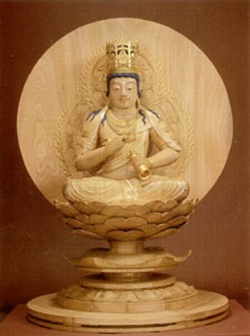Kongosatta
(Japanese form of Vajrasattva).
Symbols: vajra (thunderbolt), ghanta (bell).
Colour: pinkish white.
There is a divergence of opinion in Japan in regard to the divinity whose representations seem to correspond with that of Vajrasattva in Tibet.
He is seated with the legs locked, dressed like the usual Japanese Bodhisattva. The right hand holds the vajra at the breast, like Vajrasattva.
The left hand rests the ghanta on the left knee instead of holding it on the hip like Vajrasattva. He may have from two to six or more arms, and has both a 'mild' and 'ferocious' form.
The 'mild' form has usually two arms, and is seated on a lotus-throne which is often supported by an elephant, 26 for which reason he is sometimes mistaken for Fugen (Samantabhadra), especially as the elephant frequently has three heads 27 and is always white (PI. IV, fig. b, and PI. v, fig. c).
The vajra and ghanta, however, are not Fugen's symbols (v. Fugen), and the elephant may have four heads.
If this form has four or six arms, the original arms hold the same symbols as the above, and in the same manner, while two of the accessory arms always brandish the bow and arrow (v. TrailoJcya-vijaya). If there are six arms, the symbols held by the fifth and sixth may vary.
Kongosatta may also be supported by four elephants, on each of which is one of the Lokapala or guardians of the Four Cardinal Points (PI. iv, fig. a).
He holds the vajra and ghanta; but instead of the bell, he may hold a lotus, which is the symbol of Samantabhadra, and this seems to be a form of Kongosatta and Fugen merged into one.
One often finds him in Japanese as well as in Tibetan mandala (magic circles) in the centre, surrounded by the four Lokapala.
He is always represented seated, holding the vajra against the breast with the right hand, and the ghanta in the left which lies on his lap.
[Page 7] The 'ferocious' form has six arms, a third eye, and a ferocious expression. Above the forehead is a skull, and a vajra issues from the tishntsha.
The vajra and ghanta are carried in the same position as the above form, and he holds the bow and arrow and other Tantra symbols.
The author has never seen the 'ferocious' form supported by an elephant. He is worshipped by the Tendai and Shingon sects, and is called 'Aizen-myo-o (PL v, fig. b, and PI. xxxix, fig. a).
He is found in a triad with Kwan-non and Fudo and, in spite of his ferocious appearance, is looked upon by the common people as god of Love.
As both the 'mild' and 'ferocious' forms hold the same symbols, in the same manner, may not Aizen-myo-6 be termed the 'ferocious' form of Kongosatta?
